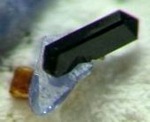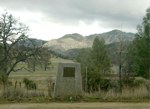Benitoite Info
Back to Benitoite
General
Benitoite is a rare, sapphire-blue (very rarely pink) mineral, a silicate which contains barium, cesium, fluorine, iron, lithium, manganese, niobium, and titanium, almost exclusively mined at the serpentine body of the New Idria Mining District, near the San Benito River in San Benito County, California, USA.
It is hard enough (Mohs scale 6.5) to be used in jewelry but still rather unknown to the public. Faceted benitoite gemstones weight almost always less than 1 ct. A faceted, clear benitoite with a good color, over 0.5 ct, is also rare.
Formation
 |
| Benitoite, Neptunite and Joaquinite |
Resources
 |
| Clear Creek * |
 |
| Benitoite Plaque at Coalinga Rd. * |
Four other mines are located within a 10 km radius at the Clear Creek: The "Junnila Mine", about 8 km northwest of the "Benitoite Gem Mine", the "Numero Uno Mine", the "Victor Claim" ("Victor Mine"), and the "Santa Rita Peak Property".
Besides the San Benito County, benitoite of lower quality is found only in Arkansas ("Diamond Jo Quarry" / Magnet Cove / Hot Spring County / Arkansas / USA), Big Creek (Sierra Nevada / Fresno County), Japan (Ohmi / Itoigawa / Niigata Prefecture / Chubu Region / Honshu Island), and Broken Hill (New South Wales / Australia).
* Photo by kind permission of © www.schweich.com, Tom Schweich.
* Photo by kind permission of © www.trinityminerals.com, John Veevaert.
Color
The sapphire blue (with a hint of violet) color of benitoite (sometimes called "blue diamond") is probably based on traces of iron. Very rarely clear, white, greenish-gray, pink, orange, red, and maroon crystals (with inclusions of other minerals like neptunite) are found. Benitoite has a higher birefringence than diamond. Because of its strong dichroism benitoite can show no color or blue or violet. Under short wave UV light it fluoresces bright blue, under long wave UV light some crystals show a reddish color. Benitoite's dispersion can cause a twinkle with flashes of red and green.
Quality
Large, faceted benitoites (over 1 ct) are very rare. They usually show a rich blue. Crystals can be cut into gems, as striking and flawless as the best sapphires. Some purchasers prefer a darker blue, others prefer a brighter stone in which dispersion is more evident. No treatments or enhancements are known for Benitoite.
Similar to sapphire, ruby and other well-known gemstones large, rich blue benitoite is very expensive if it is eyeclean or even better. Very light blue or dark blue stones are less valuable. In contrary to most other gemstones the cut is less important because one always tries to achieve the largest faceted stone, despite of windows and phantasy cuts.
Interesting links
Benitoite Mine.com
⇐ Intro Page ⇐ Gemstones ⇐ Benitoite